|
Types
of Rigs
|
|
Fore and Aft rigs Also known as a schooner, the fore and aft rig was a popular choice with shipbuilders, sailors and fishermen alike. The sails on a schooner lie along the same plane as the ship's fore and aft line - on the ship's keel. This means the rig could receive wind on either side, offering some distinct advantages - the ships could point higher into the wind, and were easier to maneuver along the coast. As well, men were not needed to go aloft in a fore and aft rig, making smaller crews a reality and saving ship owners considerably on manpower. The boats were mainly used in the coastal and fishing trades, although many of these large vessels were kept in active service, crossing the seas, laden with goods enroute to foreign ports. There were a variety of different types of schooners on the high seas. |
|
Grand Bank Fishing Schooner Probably the best known example of a Grand Bank Fishing Schooner is Nova Scotia's much loved and celebrated Bluenose. The ship has a main gaff topsail and a fisherman's staysail set between the masts in addition to her normal lower sails. |
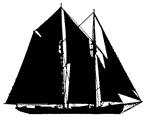
|
|
Two Masted Fishing Schooner Shown in winter rig. Her topmast and all light upper canvas have been struck and sent ashore. |
 |
|
Square Topsail Schooner This ship offers a combination of fore and aft and small square sails. She was a popular choice for coastal traders in the early 1800s. Numerous square topsail schooners were built in Prince Edward Island during this time period, with many being sold in Great Britain. One variation on this rig, with raked masts, known as the Baltimore Clipper, was popular with privateers during the War of 1812. |
 |
|
Coastal Schooner The coastal schooner was a small but mighty rig - known as the workhorse of the coastal trade. This two-masted schooner carried everything from timber and coal to general cargo, and even loads of hay for offshore island communities needing to feed their livestock. The schooner here is shown with a main topmast sail, although others in service also had a fore topmast. And look closely - see the small yawl boat towing astern? |
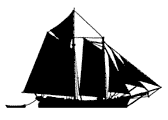 |
|
Four-Masted Schooner This large rig is shown at anchor. Her design was an effort to reduce the sail area of the individual sails, raise tonnage and still be manageable with a small crew - she could be operated with only eight hands. She was frequently used in the coastal trade along North and South America as well as the West Indies, although some trans-Atlantic voyages were also made to Europe and West Africa. Nova Scotia built a number of these schooners, although they had all but disappeared by the start of World War One. In New England, a host of five and six-masted ships were built, along with one seven-masted rig. |
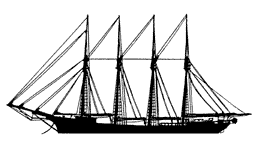 |
|
Tern Schooner The tern schooner was a three-master, and likely got its name from the Latin word terni, which meant "a set of three", not the seabird of the same name. This ship was very popular with local shipbuilders, who built these vessels in great numbers between 1880 and 1920. She was a cargo carrier, needing a crew of between six and eight hands. The schooner shown her with all sails set, with the exception of the staysails between the masts. These ships, largely made of softwood, would become waterlogged over time, sails would wear out and spars would break. Most terns were replaced as cargo ships by the steamer. |
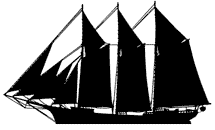 |
|
The Square Rig The square rig was generally an offshore rig, used on long ocean voyages, where the rig could take advantage of the prevailing winds and global patterns. Her size varied widely - from only a couple of hundred tons to the great full rigged ships that would measure 2,000 tons or more. The sails on a square rig were at right angles to the ship's keel, meaning that larger crews were needed to send men aloft to set or take them in, based on the winds. The square rig was also used in the coastal trade, along the eastern seaboard. With the advent of steam, steel and iron in shipping, square riggers quickly fell out of favor in the early 20th century. |
|
Brigantine This ship was two-masted, with a square rigged sail on the foremast, plus fore-and-aft sails on the mainmast. Perhaps the most well-known brigantine is the Mary Celeste (you could link to the story here) - the so-called "mystery ship", where the officers and crew vanished without a trace in 1872. This brigantine shown here has two staysails set between the masts. |
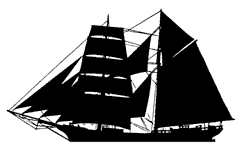 |
|
Brig Built in great numbers throughout Europe, the brig is an old and efficient two-masted vessel that is square rigged on both masts. She was in use as a transport ship for many years, right up to the very end of commercial sailing ships. |
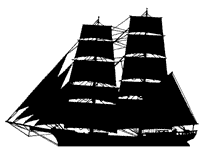 |
|
Barquentine The foremast is rigged square with the other masts rigged fore and aft on this ship. The example shown here is similar to the Maid of England, built in 1919, the last Canadian commercial vessels to carry a square rig. The Maid of England was abandoned at sea on 1928. |
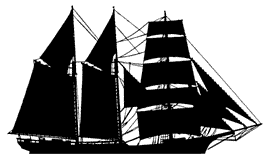 |
|
Bark or Barque She was generally built as a three-masted ship, with the fore and main masts rigged square and the after mast rigged fore and aft. A four-masted barque was in evidence along the open seas, although very few were built in Canada. She was a popular ship, and more barque rigs were built than any other square rigs combined. |
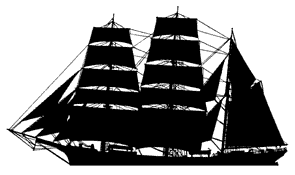 |
|
Full Rigged Ship These ships were square-rigged on all masts, although staysails could be set between the masts. The ship, William D. Lawrence, was a full-rigged ship and the largest wooden sailing ship ever built in Canada (she was built in 1874 in Maitland, Nova Scotia). Some of these ships were reduced to barque rigs near the end of their sailing careers, while others were either sold in international markets, or simply abandoned at sea. |
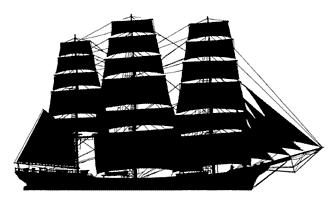 |
|
Definitions, supplied by the The Nova Scotia Museum, Department of Tourism and Culture Now that you know everything...... Build a tallship and win Pirate Pete's treasure. |


